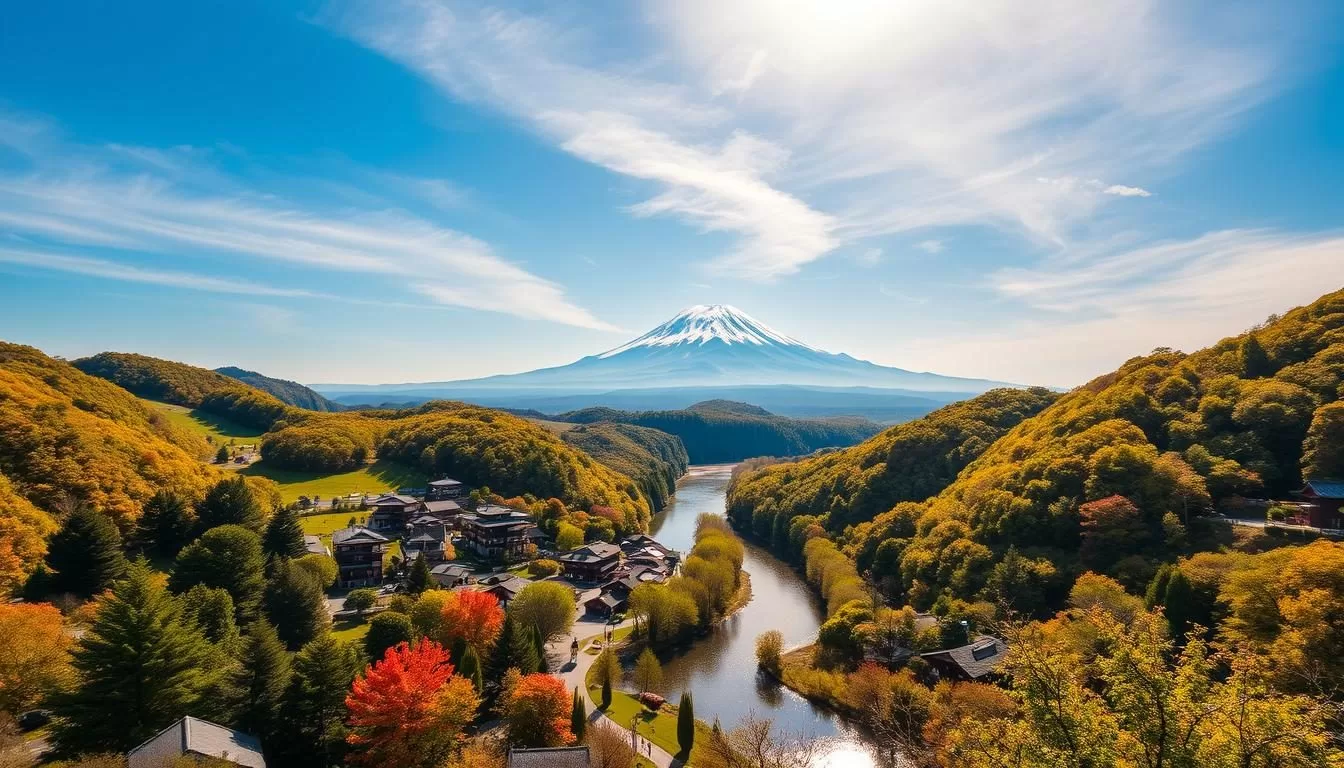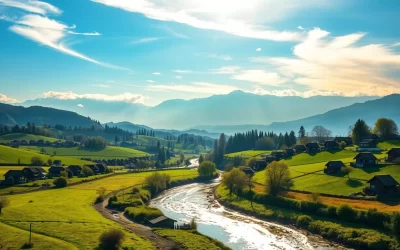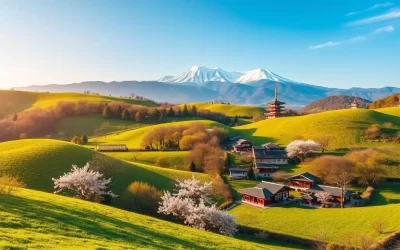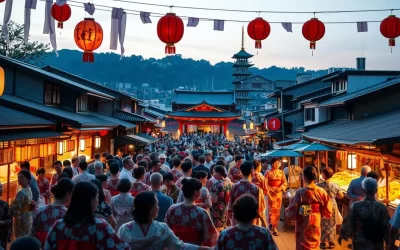Japan’s diverse geography creates dramatic seasonal contrasts, transforming the country into a kaleidoscope of experiences throughout the year. From cherry blossoms painting cities pink in spring to autumn foliage turning forests into fiery masterpieces, each season offers a unique charm.
Located in a region with a unique geography, Shizuoka Prefecture is a destination that offers diverse experiences, making the timing of your visit crucial. Whether you’re drawn to the beauty of nature, cultural festivals, or outdoor activities, understanding the local weather patterns is key to a successful trip.
As you plan your trip, you’ll want to consider the seasonal highlights and how they align with your preferences. With its distinct weather patterns and microclimates, Shizuoka offers a range of experiences that savvy travelers can take advantage of.
Discovering Shizuoka Prefecture: Japan’s Hidden Gem
Shizuoka Prefecture, situated along the Pacific coast, is a region of stunning natural beauty and varied geography. Located on Japan’s main island of Honshu, it’s nestled between Tokyo and Nagoya, making it an ideal destination for travelers.
Geographic Location and Significance
Shizuoka’s strategic location plays a significant part in its unique climate and historical importance. As you’ll discover, the prefecture’s diverse topography, from the rugged Izu Peninsula coastline to its mountainous interior landscapes, creates a fascinating nature reserve.
The region’s geographic position influences its climate, offering milder temperatures than many other parts of Japan. This makes it an attractive destination for tourists seeking a balanced experience of Japan’s varied landscapes.
| Geographic Feature | Significance | Impact on Tourism |
|---|---|---|
| Mount Fuji | Forms part of Shizuoka’s northern border | Iconic symbol attracting tourists |
| Izu Peninsula coastline | Rugged and diverse topography | Offers scenic views and outdoor activities |
| Pacific Ocean influence | Creates a maritime climate along the coast | Moderates temperatures, making it pleasant for visitors |
As you explore Shizuoka, you’ll find that its location has made it historically important as the way between Tokyo and Kyoto along the ancient Tokaido route. Today, it continues to be a significant cultural and natural destination, offering a unique blend of traditional Japan and modern attractions.
Understanding Shizuoka’s Climate Patterns
Shizuoka’s geography plays a significant role in shaping its climate, which in turn affects your travel plans. The Japan Meteorological Agency (JMA) closely monitors these variations, issuing warnings for typhoons and heavy snow.
Coastal vs. Mountain Weather Variations
Shizuoka’s unique geography creates distinct microclimates between its coastal areas and mountainous regions. The coastal areas generally experience milder temperatures compared to the higher elevations.
The influence of ocean currents on Shizuoka’s coastal weather creates more moderate conditions. In contrast, the mountains act as weather barriers, sometimes creating different patterns on either side.
- The elevation affects temperatures, with a decrease of approximately 3.5°F for every 1,000 feet of elevation gain.
- The rainy season (tsuyu), typically from early June to mid-July, impacts different parts of Shizuoka.
- Typhoon patterns may affect your travel plans, particularly during late summer and early autumn.
- Mountain areas experience more precipitation and cooler temperatures, while coastal regions deal with higher humidity and heat during summer.
| Region | Summer Conditions | Winter Conditions |
|---|---|---|
| Coastal Areas | Higher humidity and heat | Milder temperatures |
| Mountainous Regions | Cooler temperatures and more precipitation | Cold with heavy snow |
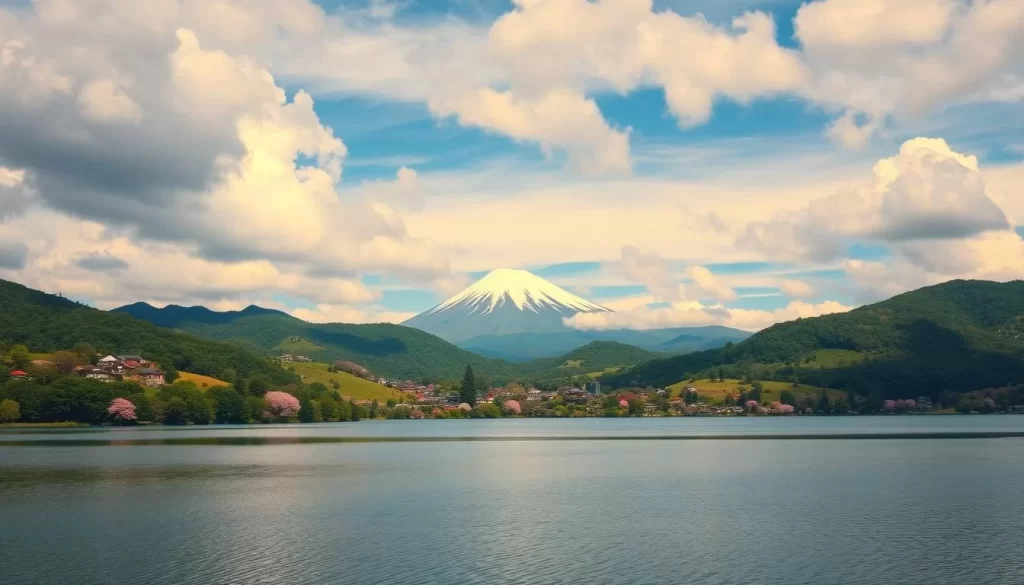
Spring in Shizuoka: Cherry Blossom Paradise
As spring unfolds, Shizuoka Prefecture transforms into a vibrant cherry blossom paradise. This season is considered by many to be the most magical time to visit, with temperatures gradually warming from March (50-60°F) through May (65-75°F).
March to May Weather Overview
The period from March to May brings a gentle warmth to Shizuoka, making it an ideal time for outdoor activities. During this time, the cherry blossoms bloom, typically from late March to early April, slightly earlier than in Tokyo.
Shizuoka’s microclimate variations cause cherry trees to bloom at different times across the prefecture, allowing for an extended viewing season. Spring brings moderate rainfall, creating lush landscapes but rarely disrupting travel plans, with April averaging 8-10 rainy days.
The spring weather creates perfect conditions for outdoor activities like hiking and cycling, with comfortable temperatures and clear visibility of Mount Fuji. Coastal areas warm up faster than mountain regions, giving you options to experience different spring environments within the same trip.
| Month | Temperature Range (°F) | Rainy Days (Average) |
|---|---|---|
| March | 50-60 | 6-8 |
| April | 55-65 | 8-10 |
| May | 65-75 | 6-8 |
When planning your trip during April and May, be prepared for the peak travel period in Japan, as locals and tourists alike partake in hanami, the annual ritual of observing the blossoms. Packing layers is essential for comfort throughout the day due to the variable spring conditions.
Summer in Shizuoka: Between Beach and Mountain
As summer unfolds, Shizuoka Prefecture transforms into a vibrant destination that offers a unique blend of beach and mountain experiences. You can enjoy the prefecture’s diverse landscapes, from the humid coastal areas perfect for beachactivitiesto the cooler mountain retreats ideal for escaping theheat.
June to August Weather Patterns
During the summer months, Shizuoka experiences a distinct climate variation between its coastal and mountainous regions. Early June is lovely, but by the end of the month, therainy seasonsets in, typically lasting until mid-July. You can expect significant rainfall during this period, which might affect your travel plans.
You can explore Shizuoka’s diverse summer offerings, including:
- Beach days along the coast, where temperatures average 75-88°F.
- Cooler mountain areas, which remain 10-15°F cooler than the coastal regions.
- Early morning hikes and evening festivals to enjoy the outdoors while avoiding the peak summer heat.
- Mountain retreats that become popular during the hottest days of August, offering natural air conditioning and outdoor recreation opportunities.
The Suruga Bay creates a unique microclimate that sometimes shields parts of Shizuoka from the worst of the summer humidity. You can enjoy a more comfortablesummerexperience by exploring these areas.
Autumn in Shizuoka: Foliage and Harvest
Autumn in Shizuoka is a spectacle of nature’s beauty, with the mountains and gardens ablaze with color. As the seasons change, the landscape transforms into a vibrant tapestry of autumn hues, attracting visitors from far and wide.
The autumn season in Shizuoka is characterized by comfortable temperatures, ranging from 65-75°F in September to 50-60°F by November. This period is ideal for outdoor activities such as hiking and photography, with clearer skies and lower humidity providing perfect conditions for capturing the stunning scenery.
September to November Weather Characteristics
During September to November, Shizuoka experiences a gradual cooling of temperatures, with the coastal areas remaining warmer than the mountain regions. The foliage typically begins in higher elevations in mid-October and continues through late November in lower areas. This progression allows visitors to enjoy the autumn colors over an extended period.
| Month | Temperature Range (°F) | Foliage Progression |
|---|---|---|
| September | 65-75 | Early autumn colors in mountains |
| October | 55-65 | Foliage peaks in higher elevations |
| November | 50-60 | Foliage in lower areas |
The autumn harvest season brings culinary delights specific to Shizuoka, including matsutake mushrooms, persimmons, and fresh tea harvests. Visitors can enjoy these local specialties while taking in the breathtaking scenery.
Winter in Shizuoka: Mild Coastal Areas and Snowy Mountains
Winter in Shizuoka brings a unique blend of mild coastal weather and snowy mountain peaks, making it an intriguing time to visit. Shizuoka Prefecture’s diverse geography means that the winter season, spanning from December to February, presents a dual climate experience.
December to February Weather Conditions
During these months, the coastal regions of Shizuoka enjoy mild temperatures, typically ranging from 40°F to 55°F, making them ideal for sightseeing without the crowds. In contrast, the mountainous areas receive significant snowfall, attracting those who enjoy skiing and other snow sports.
You’ll discover the dual nature of Shizuoka’s winter, with coastal areas experiencing mild temperatures while mountain regions receive significant snowfall. The Japan Sea and Pacific Ocean play crucial roles in shaping the winter weather patterns across the prefecture, creating stark differences between its northern and southern parts.
The clear winter days offer the best visibility of Mount Fuji all year, making it an excellent time for photography. With fewer tourists, you can enjoy a more authentic experience at cultural sites and hot springs.
- The contrast between coastal and mountain weather conditions allows for a variety of experiences within a short distance.
- Accessibility can be a consideration, particularly in mountain areas where roads may be affected by snow from December through February.
- Shizuoka offers unique winter activities, including smaller ski resorts and rejuvenating hot springs experiences.
- Practical advice on layering is essential for navigating the region’s diverse climate conditions within a single day.
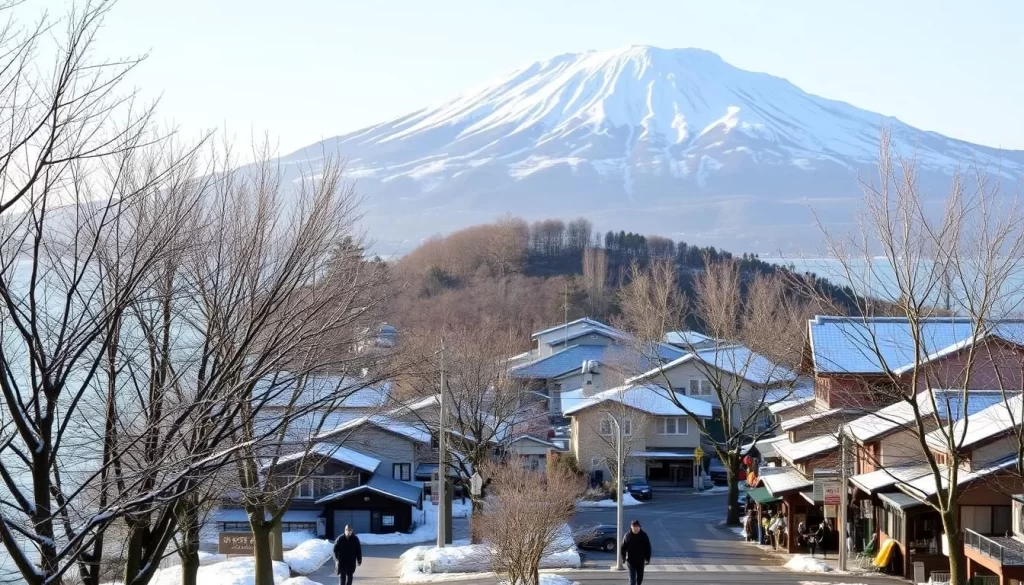
Best Months for a Weather-Savvy Trip
Shizuoka Prefecture, with its diverse landscapes, is a year-round destination, but certain months stand out for optimal travel experiences. Smart travelers target the shoulder seasons—April-May and October-November—when the crowds are smaller, and the weather is pleasant. According to 2024 tourism stats, these periods show 22% fewer crowds, making them ideal for those seeking a more relaxed experience.
The optimal months provide a perfect balance of comfortable temperatures, ranging from 65-75°F, minimal rainfall, and clear skies that are perfect for mountain views.Visiting during these shoulder seasons offers several advantages, including lower humidity, a reduced chance of typhoons, and the opportunity to witness spectacular natural displays like cherry blossoms or autumn foliage.
For travelers, these months are ideal for outdoor activities such as hiking, cycling, and water sports, without the extreme temperatures of summer or winter. Moreover, the shoulder seasons offer better value for accommodations while still allowing visitors to experience Shizuoka’s cultural festivals and natural beauty.
Optimal Months for Different Travel Experiences
The best months to visit Shizuoka align with various travel experiences. For instance, late April to early May is perfect for witnessing cherry blossoms, while October to early November is ideal for autumn foliage.
| Month | Weather | Ideal For |
|---|---|---|
| April-May | Mild, Cherry Blossoms | Spring Foliage, Cultural Festivals |
| October-November | Comfortable, Autumn Foliage | Harvest Festivals, Outdoor Activities |
By planning your trip during these optimal months, you can maximize your experience in Shizuoka, enjoying the best that the prefecture has to offer in terms of natural beauty, cultural events, and outdoor adventures.
Mount Fuji Access: Seasonal Considerations
The majestic Mount Fuji is a year-round attraction, but the right time can make all the difference in experiencing its beauty. As the seasons change, so do the opportunities to view this iconic mountain from various vantage points in Shizuoka Prefecture.
Shizuoka offers some of Japan’s most spectacular views of Mount Fuji, with different seasons providing unique viewing experiences. The winter months, particularly from November to February, are known for offering the clearest views due to lower humidity and fewer cloudy days.
Best Viewing Seasons from Shizuoka
The phenomenon of “Diamond Fuji” occurs when the sun aligns perfectly with the mountain’s peak, creating a diamond-like effect that can be viewed from specific Shizuoka locations at certain times of the year. Early mornings generally provide better viewing opportunities, regardless of the season.
| Season | Best Viewing Time | Notable Features |
|---|---|---|
| Winter | Early morning | Clear views, snow-capped Mount Fuji |
| Spring | Early morning | Cherry blossoms framing Mount Fuji |
| Summer | Late afternoon | Sunset views, potential for clouds |
| Autumn | Early morning | Foliage, clear skies |
For visitors planning to view Mount Fuji, understanding the seasonal accessibility of different Fuji viewing spots is crucial. Lakeside vistas and elevated observation points may be affected by winter snow, while spring presents opportunities to capture the mountain framed by cherry blossoms.
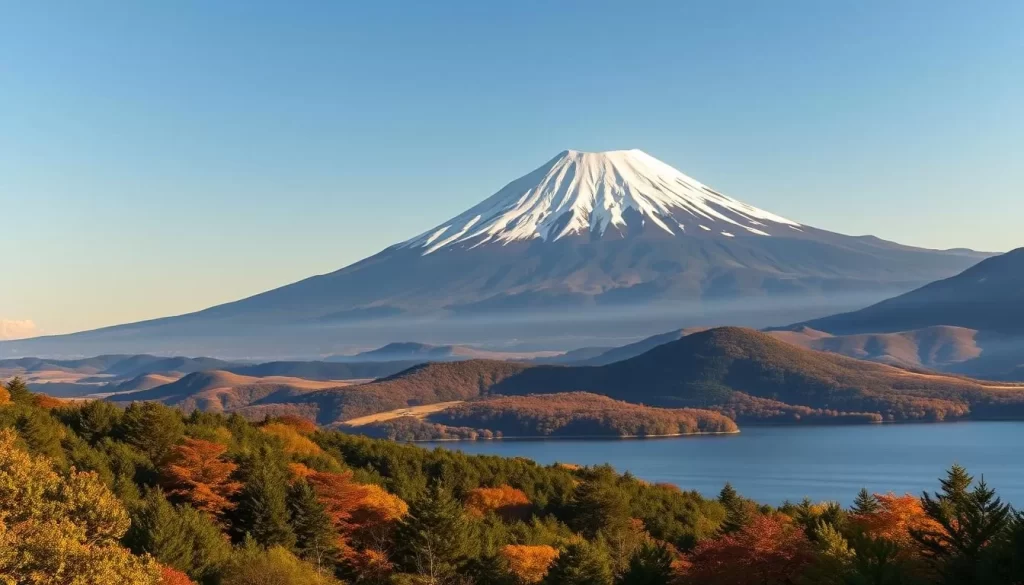
Navigating Tourist Seasons and Crowds
Understanding the ebb and flow of tourist crowds is crucial for a stress-free trip to Shizuoka. The prefecture’s popularity varies throughout the year, with certain periods being significantly busier than others.
Peak vs. Off-Peak Periods
Shizuoka experiences peak tourist seasons during cherry blossom time, Golden Week, and autumn foliage. During these periods, popular destinations are crowded with tourists. In contrast, off-peak periods offer a more relaxed atmosphere.
Visiting during the Golden Week can be challenging due to the large number of crowds. However, with some planning, you can still enjoy your trip. Consider visiting popular sites early in the morning or late in the afternoon to avoid the worst of the tourist rush.
By understanding the patterns of peak and off-peak periods, you can plan your trip to Shizuoka more effectively, ensuring a more enjoyable experience.
Budget Considerations Throughout the Year
Understanding the seasonal fluctuations in costs can significantly impact your travel expenses in Shizuoka. As you plan your trip, it’s essential to consider the time of year and how it affects your budget.
Accommodation prices in Shizuoka fluctuate significantly throughout the year. During peak seasons like cherry blossom time and autumn foliage, rates are often 30-50% higher than off-season prices. This fluctuation is driven by domestic tourism patterns and the influence of international visitors.
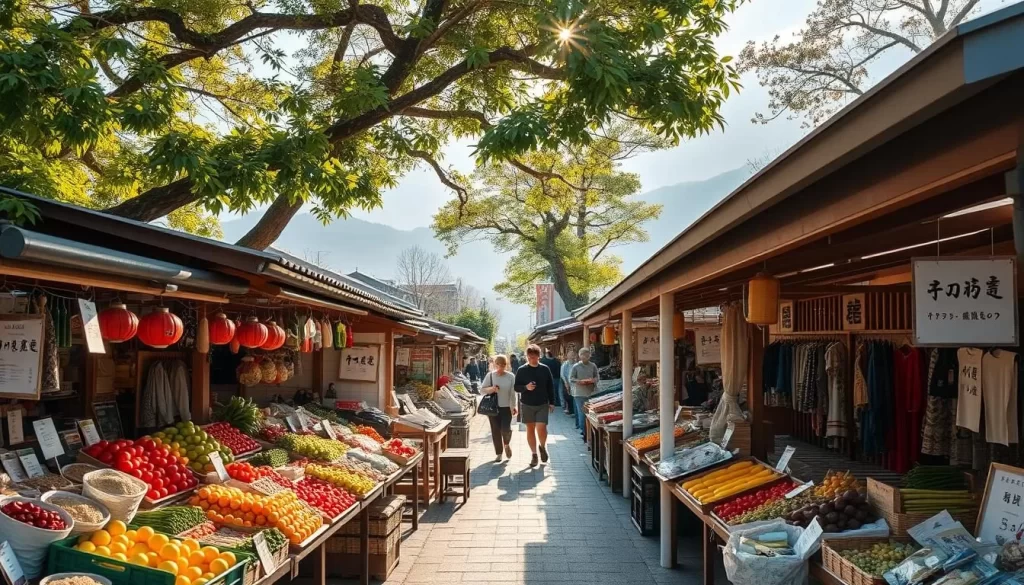
Seasonal Price Variations
The economic factors driving these seasonal pricing patterns are crucial to understanding when to find the best deals. Value seasons, such as late June after the rainy season and late November after autumn foliage peaks, offer a more budget-friendly experience.
| Season | Accommodation Prices | Tourist Activity |
|---|---|---|
| Peak Season (Cherry Blossom, Autumn Foliage) | 30-50% higher | High |
| Value Season (Late June, Late November) | Lower | Moderate |
| Off-Season (Winter, excluding ski resorts) | Lowest | Low |
By understanding these patterns, you can plan your trip during the optimal time for your budget. Additionally, considering weekday versus weekend pricing can lead to significant savings, even during popular seasons.
Packing Tips for Shizuoka’s Seasons
Shizuoka’s diverse climate means that packing the right gear is essential for a comfortable trip. You’ll want to be prepared for the unique characteristics of each season. In spring, the cherry blossoms bring mild temperatures, but it’s not uncommon for there to be cooler mornings and evenings.
For summer visits, managing humidity is key. Look for moisture-wicking fabrics and consider portable cooling options to stay comfortable.
Essential Items by Season
Layering is crucial for spring and autumn visits due to significant temperature fluctuations. For autumn, pack layers and waterproof gear. In winter, include items for both mild coastal areas and potentially snowy mountain regions.
- Layering for spring and autumn
- Moisture-wicking fabrics for summer
- Waterproof gear for rainy seasons
- Culturally appropriate attire for temples and traditional sites
Conclusion
With a grasp of Shizuoka’s diverse climate, you’re poised to make the most of your visit, regardless of the time of year. You’ve learned how each season offers unique experiences: spring brings cherry blossoms and mild temperatures, while summer offers beach activities and mountain retreats.
By understanding Shizuoka’s weather patterns, you can choose the best months for your trip, whether you’re looking for autumn foliage or winter sports. This knowledge will help you plan a trip that suits your preferences, making the most of your time in this diverse prefecture, and enhancing your overall way of experiencing Japan.
The above is subject to change.
Check back often to TRAVEL.COM for the latest travel tips and deals.
